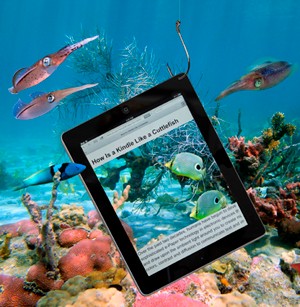
How Is a Kindle Like a Cuttlefish
Over millions of years, biological organisms from the chameleon and cuttlefish to the octopus and squid have developed color-changing abilities for adaptive concealment (e.g., camouflage) and communication signaling (e.g., warning or mating cues).
Over the past two decades, humans have begun to develop sophisticated e-Paper technology in electronic devices that reflect and draw upon the ambient light around you to create multiple colors, contrast and diffusion to communicate text and images.
And given the more than 100 million years head start that evolution has provided to these animals and their cellular systems, its not surprising that e-Paper devices lag behind in optical performance, especially color generation.
In an effort to close that gap, a multidisciplinary team led by University of Cincinnati researchers is out today with a paper that aims to help biologists who work with these color-changing creatures and engineers who work with e-Paper technology. The paper
Biological vs. Electronic Adaptive Coloration: How Can One Inform the Other?
is in the The Journal of The Royal Society Interface (electronic version) and will be featured on the cover of the upcoming print issue.
Authors are Eric Kreit, a recent doctoral graduate in UCs College of Engineering and Applied Science (CEAS); Lydia M. Mäthger and Roger T. Hanlon, research scientists at the Marine Biological Laboratory in Woods Hole, Mass.; Patrick B. Dennis and Rajesh R. Naik, scientists at the Materials and Manufacturing Directorate, Air Force Research Laboratory, Wright Patterson Air Force Base; Eric Forsythe, scientist at the Army Research Laboratory; and Jason Heikenfeld, associate professor of electronic and computing systems, also in the University of Cincinnatis College of Engineering and Applied Science (CEAS).
According to UCs Kreit, Our main goals were threefold: To allow display engineers to learn from millions of years of natural selection and evolution. To teach biologists the most advanced mechanisms and performance measurements used in human-made reflective e-Paper and to give all scientists a clearer picture of the long-term prospects for capabilities such as adaptive concealment and what can be learned from now you see me, now you dont mechanisms.
WAYS IN WHICH ANIMALS AND ELECTRONICS ARE ALIKE
One of the researchers key findings is that there are numerous approaches to change the reflective color of a surface and that the highest-performance approaches developed by both humans and nature share some powerful common features. Both use pigment, and both change or achieve color expression by either spreading or compacting that pigment. Animals use muscle fiber to spread or compact pigment, and electronics make use of an electric field to do so.
However, even if the basic approach for color change is similar, humanity has never developed anything as complex or sophisticated as the biology and physics of cephalopod skin. (Cephalopods are a diverse ocean group and include 700 species of cuttlefish, squid and octopus and are the acknowledged masters of color change on the planet).
According to Heikenfeld, The highest performance human-made approaches have been only recently developed, well after numerous other approaches were tried. Perhaps in the past, if we had more closely trusted natures ability to find the best solution, we would be further along today in creating better display technology.
ANIMALS ARE EFFICIENT USERS OF AVAILABLE LIGHT
Biological organisms that change color are very efficient at using available light. The animals skin either reflects light to achieve a bright-color effect or absorbs light to achieve stunning, multi-colored effects.
In their use of available light, the biological organisms are more efficient than electronic devices, which generally require large amounts of electric power to generate an internal/emissive light to generate bright color.
Said Roger Hanlon, Cephalopod skin is exquisitely beautiful and radiant, and can be changed in milliseconds, all without generating any intrinsic light from within the skin; there are elegant solutions from biology waiting to be translated to our consumer and industrial world.
In fact, overall, animals outscore synthetic devices when it comes to sophistication and integrated systems; required energy use for color change; size scalability (cephalopods adaptive coloration works over a wide range of sizes in the organisms class from small-size cuttlefish to large-size octopus and squid); and surface texture (cephalopods can selectively adapt or crinkle their skins to match a variety of three-dimensional textures, which provides additional light scattering and shadowing).
ELECTRONIC DEVICES ACHIEVE COLORS FASTER AND ACHIEVE MORE COLORS
Human-developed technology is far superior to cephalopods or other color-adapting animals when it comes to speed. In other words, human-made electronics can achieve color and a color change faster than the response time of a biological organism.
In addition, synthetic devices can provide a greater range of colors and more efficient dark or black state. In other words, a device can achieve a black screen, but most biological organisms cannot achieve such darkened coloring. This is, in part, due to the fact that an organism like a marine animal generally has no reason, in terms of survival adaptation or signaling, to go to a dark or black state. Such an adaptation would actually make them more visible, not less, to predators.
FUNDING
This research was funded by the Air Force Research Laboratory, National Science Foundation, Air Force Office of Scientific Research, Army Research Laboratory, Defense Advanced Research Projects Agency and the Office of Naval Research.
Related Stories
Bearcats Racing speeds toward a victorious season
April 12, 2025
Bearcats Motorsports, Bearcats Baja and Bearcats EV are racing to build winning car models at UC’s 1819 Innovation Hub as competition season approaches.
CEAS Expo unveils inaugural innovation awards – discover the...
April 11, 2025
During the CEAS Expo’s first-ever 1819 Innovation Awards, five groundbreaking inventions received recognition. Learn about prize winners from the CEAS Expo and their transformative projects.
UC recaptures national championship in disc golf
April 10, 2025
The University of Cincinnati’s “Discats” won the national disc golf championship for the second time in three years.
